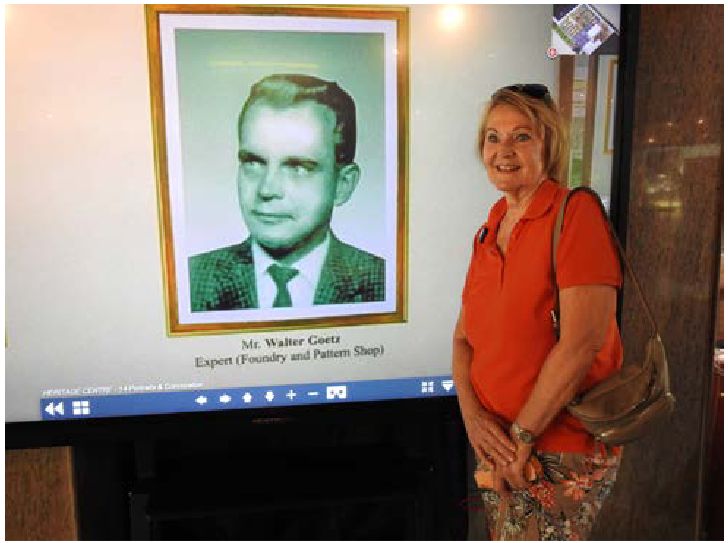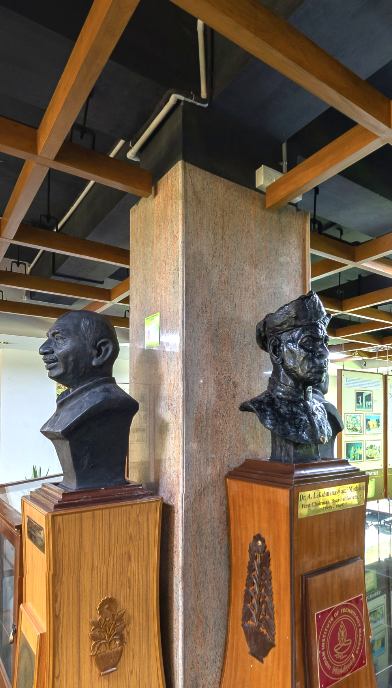
-
Letter from Heritage Centre - January 2024
Jan 24, 2024
Kumaran Sathasivam
The Great Transformation
This letter is about an environmental phenomenon that took place in the IIT Madras campus and the adjoining Guindy National Park over a few decades. We now have a clue to the question of why this transformation took place. That clue came from the daughter of Mr. Walter Götz, one of the German experts who lived on campus in the early years of
the institute.
Walter Götz (in white) at the Foundry and Pattern Shop, Central Workshop, IIT Madras in 1967. The gentleman at the left is possibly Prof. F. W. Lohr (Mechanical Engineering Department). Also in the picture are Mr. Dietrich von Mirbach (Ambassador of the Federal Republic of Germany, third from left) and Prof. S. Sampath (Deputy Director).
Born in Bochum on 4 March 1925, Walter Götz hailed from a family of foundry men. He took up the family profession. When he was 14 years old, he became an apprentice in foundry and moulding practice at Germany’s biggest steel and iron foundry, Fried. Krupp A.G., Essen. He worked in the same company and in the Mechanite Iron Foundry Eickhoff in Bochum from 1943 to 1945. During this period, he also underwent a course in iron and steel production at the state Government Engineering College, Duisburg. Götz came to IIT Madras in 1960 with his wife and four year old daughter. He built the foundry at the Central Workshop and taught students till 1970.
Then

This image shows a satellite’s eye-view of IIT Madras and the land that is today Guindy National Park (GNP), as well as the Guindy race course and adjoining areas. The satellite photograph is the one I had highlighted previously in Letter from the Heritage Centre (issue dated 2 November 2017) with reference to Mandakini Hostel. The view is probably from 1966 or 1967.
Look at the extent of tree cover IIT–GNP has, seen in the photo as black speckling, compared with the land around these spaces. The buildings on our campus stand out starkly against the vegetation, as do the bare tracks radiating across GNP.
On examination, you will note that the tree cover is thick in places. But in many others, the trees and shrubs appear to be spaced far apart. Vast gaps are visible between trees in these sparsely covered stretches. Over the years, a big change took place. Just see the next image.Now

Image: Google Earth, https://earth.google.com/web/search/iit+madras/@12.99776566,80.22841207,32.38155335a,6421.78296634d,35y, 0h,0t,0r/data=CigiJgokCWPf3DYi8ztAEUpgOLJo6DtAGeyJ5E5XqlFAIQrLUI_So1FA
This is how the same area looks today in Google Earth. As I mentioned in the Mandakini Hostel letter, a great many buildings have come up in the neighbourhood of the IIT Madras campus and GNP. In fact these places are tightly surrounded by a dense matrix of constructions.Ignore the changes in the land use around the campus. Look at the vegetation instead. It has grown distinctly more dense, compared with the late 1960s—in both IIT Madras and GNP. Gone are the spaces between trees, no more is the exposed surface of the earth visible. The paths fanning through GNP cannot be seen any longer. In IIT, the change is perhaps even more dramatic, particularly in the Hostel Zone, the Academic Zone and the oxidation ponds–stadium area. Trees have come up everywhere, and possibly the existing trees have grown taller and extended their canopies. This change in the vegetation is surprising. After all, this was the Guindy Forest. We know that this had been a ‘park’ for more than a century, presumably left to its own devices. One expects the vegetation in such a forest to have stabilised. But there has evidently been a spurt in the tree cover of the forest in the last fifty or sixty years. Was this related to the creation of IIT Madras?
Assume that the transformation of the forest did take place because of the coming into existence of IIT Madras.
What particular factor could have led to the increase in the extent of the canopy?
At the risk of oversimplifying things, one could think of some possibilities:
• There might have been a change in the water regime of the area. The forest might have started receiving more
water, say from borewells or from runoff being retained. This seems unlikely, all things considered.
• There might have been a lot of tree plantation activity. Yes, but that too sounds unlikely since IIT and GNP
are under different managements. No, there must have been a common factor.
• Was the forest being grazed by cattle and goats, maybe from Taramani and Velachery, in and before the 1960s?
Did the construction of boundary walls exclude this livestock and allow the forest to flourish subsequently?
Maybe. Indeed, there is support from Delia Roedel’s recollections for the notion that this is what happened.Delia is Walter Götz’s daughter. She spent her youth in Madras, living on 2nd Cross Road, in the IIT campus.
Now she is 67 years old, and even now she remembers clearly all the places in IIT that she went around with her friends as a child.
One thing Delia remembers is that there were many cows on the roads in the campus then. She remarks that she does not find any now.
Many cows on campus? No doubt they ranged in GNP as well in those wall-free days. Imagine the effect they would have had on the forest.Your response to Letter from Heritage Centre is welcome.
Please send mail to heritage@iitm.ac.in.
The Heritage Centre is located in the ground floor of the
Administration Building, IIT Madras.
It is open on weekdays from 9.30 am to 7.00 pm
heritage.iitm.ac.inYour response to Letter from Heritage Centre is welcome. Please send mail to heritage@iitm.ac.in
The Heritage Centre is located in the ground floor of the Administration Building, IIT Madras. It is open on weekdays from 9.30 am to 5.30 pm.
- Contribute
to the Centre -
Monetary
Support - Digital
Material









